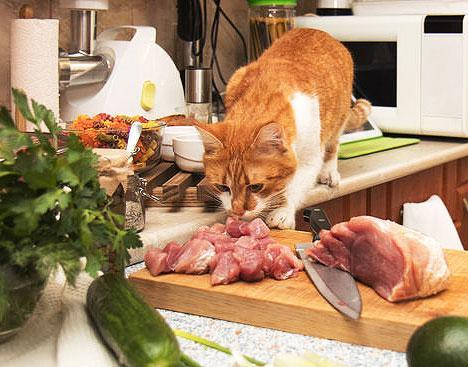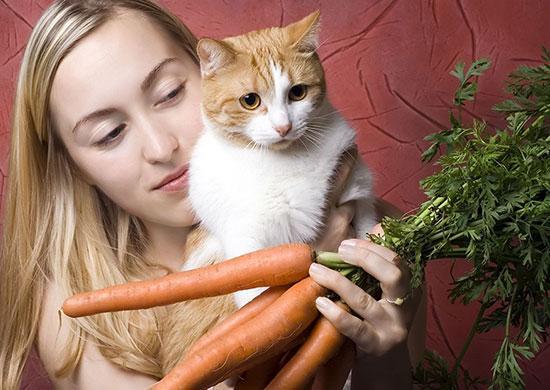This content is archived from the Feline Nutrition Foundation
There's No Such Thing as a Vegan Cat
- Updated: Saturday, June 01, 2019 05:31 PM
- Published: Saturday, September 08, 2018 02:12 PM
- Written by Guillermo Díaz. MV
The reasons people give for becoming vegetarian or vegan are diverse. Primarily, it's the desire to become healthier and to prevent or stop cruelty to animals. Those are admirable reasons, but extending that desire to your cat, an obligate carnivore, is a recipe for disaster.¹ These cat owners don't realize that, in trying to convert their feline companion into a "vegan carnivore," they themselves are inflicting cruelty on their cats. I call this passive cruelty, because in doing so they disrespect and go against the true nature of cats, who are designed to extract their nutrients from raw meat and bones, not from plants and vegetables, as rabbits, cows or horses do.
Every single cat is born with a set of natural instincts - such as hunt, catch, kill - that remain unaltered despite living with us. These natural instincts are amongst the reasons why they are so lovable to us. When we throw a paper ball or when kitty jumps up high to catch the feather attached to a string we weave through the air, for the cat, that is real hunting. Kitty is a predator, plain and simple.
Many vegan advocates state that even wild cats consume vegetables from their prey, and that's enough reason for them to consider cats as potential herbivores. They are dead wrong. Outdoor and wild cats can consume plant matter as presented in the gastrointestinal tract of the prey they hunt. Very small prey, such as mice, might be eaten whole, and thus the gut would also be consumed. But for larger prey, the gut would likely not be consumed. The plant material from the gut of prey accounts for only one to ten percent of the overall diet, usually towards the lower end of that range. The main difference remains here: most fibers and plant material cats consume in nature are entirely different metabolically than high-glycemic carbohydrates present in dry commercial and vegan diets. Raw meat diets have a much lower glycemic index, which helps reduce insulin resistance, inflammation and post-oxidative stress.
All protein is made from only 23 different amino acids. Cats are able to make only 12 amino acids, which don't specifically need to be present in a cat's diet since they can synthesize them. These are called non-essential amino acids. Then there are the other 11 amino acids their bodies need which cats can't produce or synthesize and must be obtained directly from their diet. These are called essential amino acids: arginine, histidine, isoleucine, leucine, lysine, methionine, phenylalanine, threonine, tryptophan, valine and taurine.² ³

The protein in animal tissue has a complete amino acid profile. Plant proteins do not contain all of the amino acids critical for the health of carnivores.⁴ If a plant-based-only diet is fed for long enough, these nutrient deficiencies can lead to serious and sometimes irreversible medical conditions. A lack of any essential amino acid in the diet will eventually lead to health problems.⁵ For example, arginine deficiency causes toxic levels of ammonia to build up in the body, resulting in vomiting, muscle spasms, seizures, coma and death.⁶ A shortage of taurine induces cardiomyopathy, a serious form of heart disease, central retinal degeneration and blindness.⁷
Animal-based protein sources, such as meat, eggs, dairy and fish, contain more essential amino acids than do plant-based protein sources, e.g., wheat, rice, soybeans or corn gluten meal. Products that rely on plants to provide most of their protein cannot provide all of the essential amino acids cats need without supplementation, even if the food appears to be high-protein based on its guaranteed analysis. In the case of vegetarian and vegan diets, the amino acids, vitamins and minerals must be heavily supplemented, and thus come from synthetic or lab-created sources. This is not ideal, as diets of whole foods as presented in nature, with minimal processing, yield better nutrition.⁸
Besides the issue of a lack of a complete amino acid profile, vegan and vegetarian diets are, by their nature, far too high in carbohydrates for an obligate carnivore. If you are making a diet from plant sources, carbohydrates are going to be a major source of the calories in the food. Cats have no requirement for carbohydrates; all they need are fats and protein. A vegan/vegetarian diet simply can't provide that.
Additional Reading
Answers: What Exactly is an 'Obligate Carnivore?'
There's No Kibble Served at the Big Cat Rescue
Cats are strict carnivores. They're from the same biological family as lions, tigers, jaguars, mountain lions and other big cats. All cats need to eat more protein than do dogs or people. These levels can be hard or impossible to reach with a vegetarian diet and particularly a vegan diet. Cats that don't get adequate amounts of protein, taurine, niacin, arachidonic acid and vitamins A, B1 and B12 in their diets are at risk for eye disease, skin and coat problems, blood clotting disorders, immune system dysfunction, poor growth, weight loss, inflamed gums, diarrhea, neurologic disorders and death.² ⁹
If feeding meat to your cat is going to be an issue, please consider adopting a true vegetarian instead. Rabbits, chinchillas and guinea pigs can be wonderful pets.
Dr. Guillermo Díaz and family, including their four dogs (Leroy, Xica, Moza and Pepa) and six cats (Michalina, Tigger, Vladimir, Yellow, Mongo and Chirusa) moved to Buenos Aires, Argentina in July of 2017, where he expects to continue supporting different animal rescue groups, spread the benefits of raw food for cats and dogs and write articles about nutrition.
1. "Kitten Nearly Dies From Vegan Diet," Herald Sun, July 21, 2013.
2. ML MacDonald, QR Rogers and JG Morris, "Nutrition of the Domestic Cat, A Mammalian Carnivore," Annual Review of Nutrition, no. 4, 1984, 521-562.
3. CA Buffington, "Dry Foods and Risk of Disease in Cats," The Canadian Veterinary Journal, no. 49, 2008, 561-563.
4. Harvard TH Chan School of Public Health, "The Nutrition Source: Protein."
5. A Wortinger, BIS, LVT, VTS, "Cats: Obligate Carnivore (Proceedings), Central Veterinary Conference, Aug 1, 2010.
6. JG Morris and QR Rogers, "Arginine: An Essential Amino Acid for the Cat," The Journal of Nutrition, vol. 108, no. 12, Dec 1, 1978, 1944–1953.
7. KC Hayes, "Nutritional Problems in Cats: Taurine Deficiency and Vitamin A Excess," Canadian Veterinary Journal, vol. 23, no. 1, Jan 1982, 2-5.
8. PR Buff, RA Carter, JE Bauer and JH Kersey, "Natural Pet Food: A Review of Natural Diets and Their Impact on Canine and Feline Physiology," Journal of Animal Science, no. 92 (9), 2014, 3781-91.
9. National Research Council (NRC), "Carbohydrates and Fiber: Nutrient Requirements of Dogs and Cats," National Academies Press, Washington, DC, USA, 2006, pp. 49-80.





